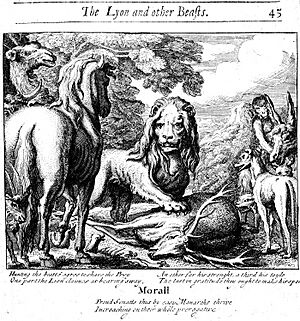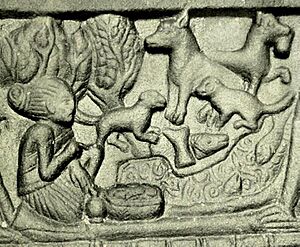Lion's share facts for kids
The lion's share is a common saying that means getting the biggest part of something. This phrase comes from old stories called Aesop's Fables. There are a few different versions of these fables.
In these stories, animals divide their hunting spoils. The lion always ends up with most, or even all, of the catch. In English, people started using "the lion's share" to mean "nearly all" around the late 1700s. The French version, le partage du lion, was used earlier, after La Fontaine's Fables became popular.
The Phaedrus Fable: An Unequal Partnership

An early Latin version of this fable was written by Phaedrus. It starts by saying, "It's not always safe to team up with someone much stronger."
The story tells how a cow, a goat, and a sheep go hunting with a lion. When they catch something, the lion decides how to divide it.
The lion says:
- "I take the first part because I am the king."
- "The second part is mine because I am your partner."
- "The third part is also mine because I am the strongest."
- "And if anyone touches the fourth part, something bad will happen to them!"
This version was recorded as Fable 339 in the Perry Index. William Caxton also included it in his collection of fables in 1484.
Many versions of this story existed by the Middle Ages. Marie de France included two in her 12th-century book, Ysopet. Both were called "The Lion Goes Hunting." In one, the lion hunts with a wild ox and a wolf. In another, the lion hunts with a goat and a sheep. In both cases, the lion claims all the parts, either by right or by threat.
La Fontaine's Fables also has a version (Fables I.6). In his story, a heifer, a goat, and a lamb hunt with the lion. The lion takes all four parts. He claims them because he is king, the strongest, and the bravest. He also threatens to kill anyone who touches the last part.
The Babrius Fable: Learning a Hard Lesson
In a longer Greek version by Babrius, a lion and a wild donkey hunt together. The lion is strong, and the donkey is fast. The lion divides their catch into three parts. He takes the first part because he is the king of the beasts. He takes the second part because they are "equal" partners. Then, he tells the donkey to run away quickly and not dare to touch the third part.
The lesson from Babrius is clear: "Know your limits! Don't get involved in business or partnerships with someone more powerful than you."
Another version of the fable appeared in the Middle Ages. In this story, a fox joins the lion and donkey on a hunt. The donkey divides their catch into three equal parts. The angry lion then kills the donkey and eats it.
The fox, seeing this, puts almost everything into one pile, leaving only a tiny bit for herself. She tells the lion to choose his share. When the lion asks how she learned to share this way, the fox wisely replies, "From the donkey’s bad luck." This version is Fable 149 in the Perry Index. Writers like Gabriele Faerno and Hieronymus Osius followed this story.
Eastern Fables: The Clever Divider
There are similar fables from the East. They show how someone powerful takes advantage when dividing things. These stories are like type 51 in the Aarne–Thompson–Uther Index, which is a way to classify folk tales.
A 10th-century Arabic book, the Encyclopedia of the Brethren of Purity, tells a story from India. A group of foxes finds a dead camel. They can't agree on how to divide it. They ask a passing wolf to divide it fairly. The wolf starts to divide it but then decides to keep it all for himself, because he is stronger. (However, in this story, the foxes complain to the lion, who kills the wolf and gives the camel back to the foxes.)
Another Indian story is the Dabbhapuppha Jataka. This tale features different animals but has the same idea of an unfair division. Two otters catch a fish and argue over it. A jackal offers to help them divide it. The jackal gives the otters the head and tail, then runs off with the biggest part of the fish.
This story teaches that greed can cause problems. It also suggests that powerful people can change rules to benefit themselves. The story ends with a verse:
-
- Just as, when arguments happen among people,
- They look for someone to settle it: he becomes the leader then;
- Their money disappears and the king's treasury grows.
This tale is similar to another of Aesop's fables, The Lion, the Bear and the Fox. In that story, a lion and a bear fight over a young goat they both attacked. They both get too tired to move. A fox then steals their prey. The lion and bear are left to think, "It would have been much better to have shared in a friendly way."


